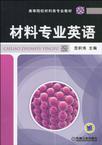材料专业英语
2010-5
机械工业
范积伟 编
245
无
材料是人类物质文明的基础,新材料是社会不断发展进步的一大支柱,新材料的研究开发极大地促进了工业发展和社会进步。英语作为一种重要的全球化的交流工具,发挥着重要的作用。学好英语,尤其是专业英语,是学生、学者和工程技术人员获取科研信息、掌握学科发展动态、参加国际学术交流的基本前提。材料学科涉及广泛的研究领域,具有很强的学科交叉性,日新月异的新材料发展使得材料学科的专业英语学习尤为重要。为此,我们编写了本书,希望能对从事材料科学与工程的工程技术人员、研究生、本科生的专业英语水平的提高有所帮助。 本书分为8章,每一章含3-4节,分别对应于材料科学的不同领域。前7章中,每一节均由一篇课文和一篇阅读材料组成。阅读材料提供了与课文对应的背景知识或者是课文的续篇,从而进一步拓展了课文的内容。全书共29节,课文及阅读材料共计55篇,涵盖了金属材料、陶瓷材料、高分子材料、复合材料、生物医学材料、纳米材料和工程应用等内容,涉及面广,学科全面。本书附录A为化学元素的中英文对照表。附录B为新版元素周期表。另外,英美科技文章中经常出现的非公制单位往往使读者感到困惑,为此,附录C给出了英美度量衡系统与公制系统之间的关系。附录D列出了本书的主要词汇。 本书具有以下几个特点: 1.知识面广,趣味性强。涉及材料科学相关专业的各类知识,论述的概念清楚、准确、简练。 2.内容丰富、新颖。55篇文章全部选自近年来出版的原版英文教科书、科技报告、专业期刊和著作,内容新颖,学科前沿知识丰富,特别突出在纳米技术和生物医学材料方面的进展。 3.词汇量大,词汇表实用。本书既可作为材料专业的英语教科书,又可用于自学。为了提高读者的科技英语翻译和写作水平,每一章都附有有关科技英语翻译及写作技巧的内容。 本书由范积伟担任主编,席艳君、王艳芝担任副主编。第1、6、8章由范积伟编写,第2章及科技翻译和写作技巧部分由席艳君编写,第3章由赵慧君编写,第4章由曲良俊编写,第5章由王艳芝编写,第7章由张小立编写,全书由范积伟统稿。本书在编写过程中,得到了中原工学院教务处、材料与化工学院领导及同仁的支持和帮助,在此表示衷心的感谢。
本书课文和阅读材料全部选自近年来英、美等国材料科学专业教材和专业刊物,共55篇,涵盖了金属材料、陶瓷材料、高分子材料、复合材料、生物医学材料、纳米材料和工程应用等内容。所选文章题材多样,内容新颖,学科前沿知识丰富,融知识性和趣味性于一体。为了提高读者的科技英语翻译和写作水平,每一章都附有有关科技英语翻译及写作技巧的内容。读者可在掌握材料专业英语和翻译及写作技巧的同时进一步学习材料专业的有关知识。 本书可作为普通高等院校材料科学与工程类专业本科生、研究生的专业英语教材,也可供材料科学研究人员、工程技术人员学习和参考。
前言Chapter 1 Introduction to Materials Science and Engineering 1.1 What Is a Material? 1.2 Classification of Materials 1.3 Fundamental Properties of Different Kind of Materials 科技英语翻译技巧(一):词义选择和引申Chapter 2 Metals and Alloys 2.1 Atomic Arrangements and Imperfects in the Atomic Arrangement 2.2 Thermal Equilibrium Diagram 2.3 Casting 2.4 Nonferrous Alloy 科技英语翻译技巧(二):数词Chapter 3 Ceramics45 3.1 Introduction to Ceramics ( I ) 3.2 Novel Ceramic Processing Routes ( I ) 3.3 Advanced Ceramics ( I )59 3.4 Clean Energy through Ceramics ( I ) 科技英语翻译技巧(三):常见多功能词as的用法Chapter 4 Polymer Materials 4.1 Polymers 4.2 Methods for Synthesis of Polymers85 4.3 Processing of Polymers 科技英语翻译技巧(四):常见多功能词it的用法Chapter 5 Composites98 5.1 Composite Basics—Material System 5.2 Introduction to Carbon Fiber Composites 5.3 Three?Dimensionally Reinforced Preforms and Composites 5.4 The Uses of Composite Materials 科技英语翻译技巧(五):关连词引导的句型翻译技巧(I)Chapter 6 Biomaterials 6.1 Biomaterials and Biomaterials Science 6.2 Traditional and New Generation Biomaterials 6.3 Examples of Biomaterials Applications 6.4 The Future of Biomaterials 科技英语翻译技巧(六):关连词引导的句型翻译技巧(II)Chapter 7 Nanotechnology and Nanomaterials 7.1 What Are Nanomaterials? 7.2 What Is Nanotechnology? 7.3 Nano?Crystalline Metal and Nano Metal Foam 7.4 Applications of Nanotechnology 科技英语翻译技巧(七):并列句和复合句Chapter 8 Recent Advances in Materials Science and Technology and Future Trends 8.1 Recent Advances in Materials Science and Technology 8.2 Trends in Materials Science and Technology ( I ) 8.3 Trends in Materials Science and Technology ( II ) 科技英语写作技巧Appendixes Appendix AChemical Elements Appendix BPeriodic Table of Elements Appendix CThe Metric, British and U.S. Systems Appendix DGlossary
From a practical standpoint, we know that all material objects are essential for a human beingto build things. This definition includes solids, but also liquid (e. g. , liquid crystals that createLCD displays), and even gases for more specific situations. Really, every raw material used by in-dustry could be included in this classification, but we use the word "material" in a restricted sense :We think about materials whose properties might not be an exact image of those that their elementspossess. Thus, we especially concern ourselves with how elements are structured in macroscopicbodies, with how treatments are used during the elaboration of materials, or with the physicochemi-cal aggregation of different elements——all activities that condition the properties of the materials wegenerate. The selection, modification, and elaboration of materials to satisfy our needs merge in the foun-dations of human culture. From the very beginnings of prehistory, humans have manipulated sub-stances so that they would be more useful. To create more useful materials, our forebears wanted tounderstand and control the composition of materials, and they often succeeded in modifying a materi-al' s behavior and properties and in predicting the effects of such manipulations. This task developed over time, beginning as a handcraft that employed empirical and specula-tive knowledge. The history of materials science and engineering had already begun in the Stone Agewhen stones, wood, clay, and leather began to be manipulated. In the Bronze Age, mankind dis-covered the value of temperature and used it to modify materials by thermal treatments or by addingother substances. Yet, in spite of technological improvements, materials science remained empiricaluntil the end of the nineteen century. Materials science, as we now understand it, began with theappearance of Mendeiev s periodic table. Since that time, some properties of elements that are re-lated to their position in the periodic table began to be explained scientifically~, and these resultsbecame incorporated in the annals of science. Since the end of the nineteen century, the introduc-tion of chemistry and physics, calculus, and modem experimentation have brought the use and prof-its of materials to a mature status. Currently, thanks to more reliable knowledge of the structure ofmatter, we can design new materials atom by atom, to achieve the properties we want. ……

无
材料专业英语,很实用的教材
程序包的汉拿山准备
发货真的是好慢好慢,好慢呀!!!!
书还行吧,送货速度蛮快的。
里面很多句子翻译的是错的。